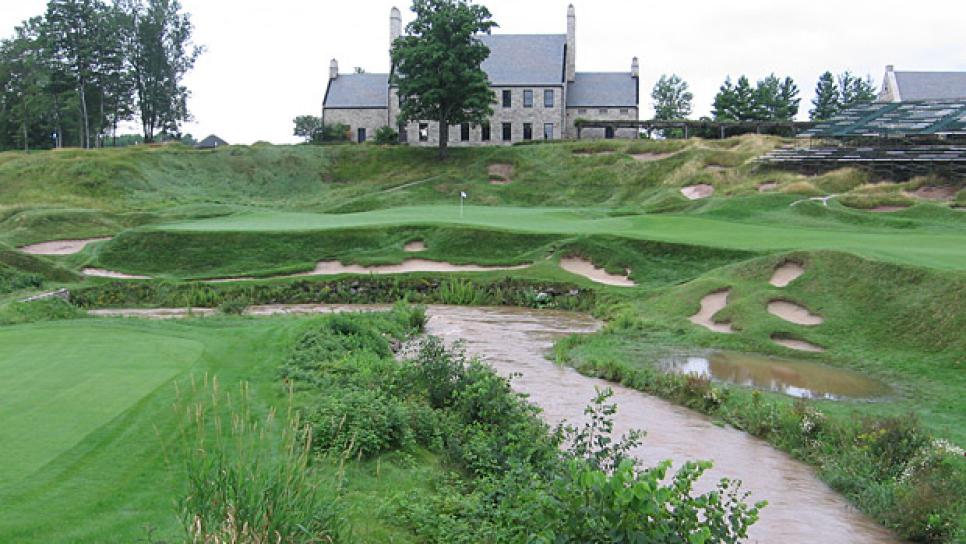News
Whistling Straits Softened By Rain

Seven Mile Creek rages through Whistling Straits, snaking past the 18th green and the restored left-hand fairway.
HAVEN, Wis. -- Once the work crews have finished their preparations for next month's PGA Championship, and all the hospitality tents, grandstands, leader boards and other accoutrements are erected, they may want to build one more structure.
An ark.
After an average snowfall last winter and a dry and hot spring, The Straits Course at Whistling Straits has absorbed far more than the usual share of precipitation this summer. Since June 1 the Sheboygan area has had 15 days with more than a tenth of an inch of rain -- three of the last 16 days exceeded an inch. No wonder Thursday's extended downpour, a seemingly endless seven-hour cascade that featured a tornado watch, left the course sopping wet and turned meandering Seven Mile Creek into a swollen mess.
It could have been much worse: the Milwaukee area, an hour's drive to the south, was pounded Thursday by more than seven inches of rain that closed the airport and caused widespread flash-flooding nightmares. Had the same storm hit Whistling Straits, it's difficult to tell what reparations could have been made in the 17 days before the first practice round.
Despite the close call the PGA's show is on pace for its unveiling. According to Barry Deach, the championship director, construction crews have lost only one day during the run-up to the event. Inside the ropes Chris Zugel, the superintendent, and his crew have been able to keep pace during this uncharacteristic season. Of course, their to- do list grew after Thursday's rain, which washed out the faces of all but a few of the 967 bunkers on the layout.
Although the course drains well, everyone concerned hopes a high- pressure front arrives soon and takes up residence through the championship's final round. Even if every footstep is squishy and the rain falls sideways, competitors in the 92nd PGA who were here for Vijay Singh's 2004 victory will find several significant changes to the course.
A fallow extension of the 500-yard 18th fairway along the left of that muddy creek, part of Pete Dye's original design but allowed to grow in for 2004, has been restored. The existing right-side fairway remains largely unchanged, but players who feel they need to gamble and can clear a cluster of bunkers 304 yards from the tee can find themselves with a much shorter approach from the old-new left fairway extension. The shamrock-shaped green has been reconfigured, too, with the back- left lobe turned into fringe and the front-right one shortened considerably.
The 355-yard sixth hole will prompt plenty of chatter early in the week. Where once three small pot bunkers nestled into the slope fronting the green, there are now two pot bunkers flanking a deep, sheer-faced, oval-shaped bunker that chews into the putting surface.
The sand at the bottom is about six feet wide and 15 feet long, and rests six feet below the putting surface -- claustrophobic dimensions. The hazard radically alters the wedge approach, essentially slicing the once kidney-shaped green in two, while tamping down thoughts of gunning for the green off the tee.
Finally, there is the 598-yard fifth, where the fairway doglegs sharply right between a pair of ponds. Dye designed the edge of the the one through the fairway so that the shoreline incorporated a bunker, an interesting hazard-in-hazard combination. Nearby wetlands and corn fields -- the latter appearing more suited to planting rice this season -- drain into the pond, raising its elevation more than a foot. What once stood as a design quirk might now see the water up to the grass line, which would make it just another hazard.
Unless it's equipped at the last minute with a hospitality ark.